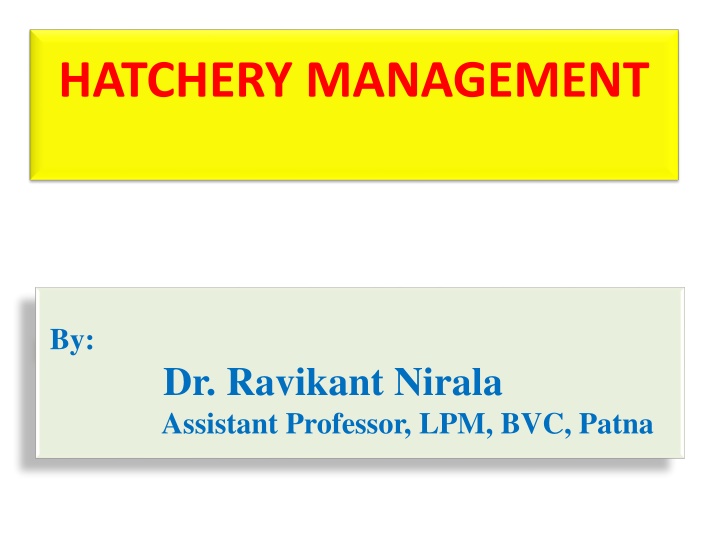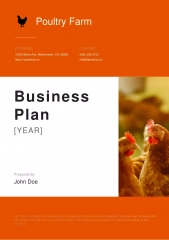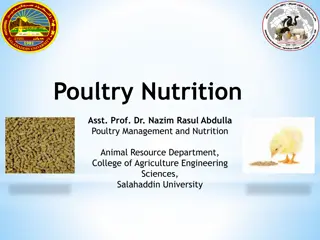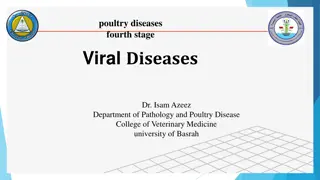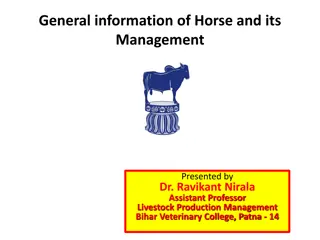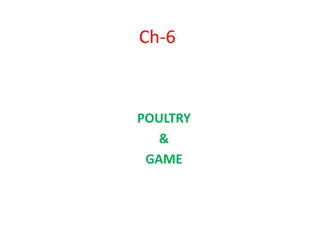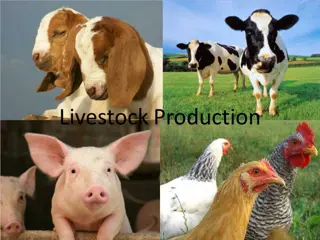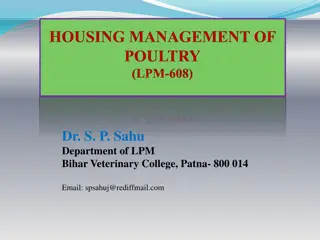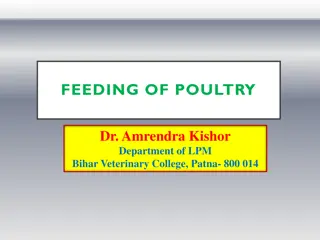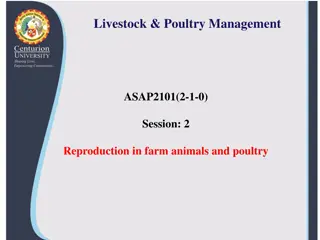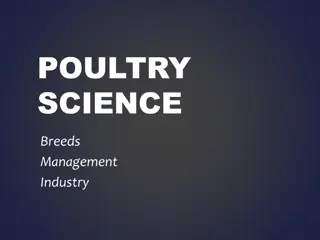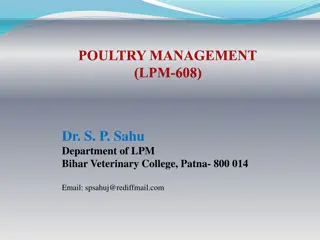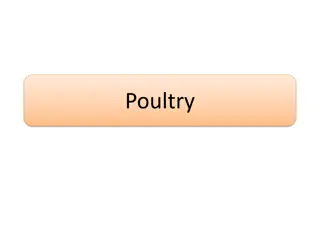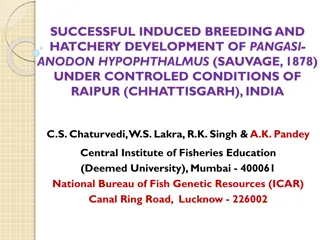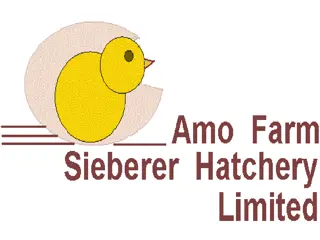Efficient Poultry Hatchery Management Insights by Dr. Ravikant Nirala
Poultry industry in India is dynamic, with high egg production rates and efficient food conversion. Dr. Ravikant Nirala provides valuable insights on hatchery management, highlighting the significance of poultry as a chief protein source. The sector contributes significantly to meeting the demand for balanced diets, with poultry manure being a valuable resource. Various poultry products find applications in different industries, showcasing the versatility of this sector.
Download Presentation

Please find below an Image/Link to download the presentation.
The content on the website is provided AS IS for your information and personal use only. It may not be sold, licensed, or shared on other websites without obtaining consent from the author.If you encounter any issues during the download, it is possible that the publisher has removed the file from their server.
You are allowed to download the files provided on this website for personal or commercial use, subject to the condition that they are used lawfully. All files are the property of their respective owners.
The content on the website is provided AS IS for your information and personal use only. It may not be sold, licensed, or shared on other websites without obtaining consent from the author.
E N D
Presentation Transcript
HATCHERY MANAGEMENT By: Dr. Ravikant Nirala Assistant Professor, LPM, BVC, Patna
Introduction Poultry is a chief source of protein. In developed world energy intake is about 30% through the grains and rest 70% from animal products, but in India vice versa. It is a value added products obtained from biological value addition by agricultural and kitchen waste materials. Eggs production in India 73 bn. and in Bihar 740 mill. The Per capita/ year 53 and 08. (2019) Poultry has short life span and speedy growth enabling them for ready acceptance. It is a species well adjustable to environmental changes as well as fluctuation in market also. Hence, poultry industry is dynamic in this regard. Poultry are easy to rear as it requires less space, less initial money to start and little attention hence considered as good source of supplementary business. This has created poultry business from backyard venture to commercial farms. There is a population growth in human population increasing demand for balanced diet for human being. Poultry products serves the purpose for the same as it s a good source of balanced diet.
Poultry is a good converter of food into either an egg or meat more efficiently than any other species as Broilers will consume 2 kg of feed to produce 1 kg of body weight. Layer birds are also utilizing 2.5 - 3.0 kg of feed to produce 1 kg of eggs. While cattle will utilize 9-10 kg to produce 1 kg of veal, pig will consume 5 kg, sheep will consume 8-8.5 kg. Poultry feed being prepared from cereals and its by-products viz. De-oiled rice bran, damaged cereals, fish meat meal, bone meal, molasses etc. which will not utilized by human being hence, even though it utilizes food as monogastric like human being, birds are not in direct competition with them with regards to food stuffs. It converts feed by-products listed above in an egg or meat which can be consumed by human being. Poultry manure produced containing good amount of N : P : K in it as compare to farm yard manure. It contains N : P : K in 3 : 2 : 2 percentage versus 0.5 % in FYM. Poultry waste can also recycled and can be used in animal feed effectively. Layers are producing 300 eggs i.e. almost every day egg production. So it form either continuous supply of proteinous diet to family members or continuous source of income through sale of egg.
Dressing percentage of poultry is higher than other species. It counts about 72.0 % in broilers against 65 % in Fish, 70 % in hog, 58 % in steer, 47 % in lamb and 55 % in rabbit. 10.Poultry produce can be utilized in various industries like egg albumin used in many pharmaceuticals, paints, varnishes and adhesives. Egg yolk finds its use in manufactures of soaps, paints, shampoos etc.; egg shell used as mineral mixture, feathers in millinery goods, endocrine glands for preparation of hormones and other biological products. Fertile eggs are used in vaccine preparation, inedible eggs from hatchery, can be used as animal feed and fertilizers. Poultry is a good laboratory animal for researchers on account of its small size, low feed intake, ease in handling, fast and sensitive metabolisms and short generation interval.
Body parts of fowl and Status of hen before and after laying
Biological value of different products Food stuffs BV Human milk 95 Egg 94 Cow milk 85 Rice 80 Liver 77 Beef 74 Pork 69 Fish 69
Principles of Incubation and Hatchery Management INCUBATI0N: Incubation is providing natural or artificial heat to eggs. The incubation temperature and the length period also varies upon the eggs of different birds. It has two units Setter and Hatcher. In Fowl eggs the setter temperature is 99.5 0C, while Hatcher temperature 98.5 0C. Hatchery business has become a specialized branch of poultry industry due to its rapid development in recent years. Now a days very few eggs are being hatched on farms. Poultry farmers obtain their' requirements of chicks from commercial hatcheries. Incubation Periods of some important birds : Chicken - 21 days Duck 28 days Geese (small) 30 days Japanese Quail - 18 days Canary birds 14 days Desi birds 20 days Muscovy Duck - 35 days Geese (large) 34 days Guinea fowl 26-28 days
MANAGEMENT OF INCUBATOR / REQUIREMENTS OF INCUBATION : 1 ) Position of the eggs : 2) Turning the eggs : 3) Regulating temperature : Forced draft - Incubator : 57.5 C ( 99 - 100 F ). Hatcher : 35.5 - 36.5 C ( 98 - 99 F ) SELECTION OF HATCHING EGGS : 1. Size of eggs : 2. Shape of an egg : 3. Shell quality : 4. Internal quality : Hatching eggs should, be selected with care because certain abnormalities adversely affect hatchability. Therefore, eggs that have characteristic associated with poor hatchability should be discarded. Some important characters for selection of hatching eggs are size, shape, shell quality and interior quality observed upon candling.
METHODS OF INCUBATION (1) Natural method : (2) Artificial method : (1) Sectional or still air type. (2) The cabinet type or forced draft type. (1) Sectional or still air type: This incubator is usually of small capacity from 50-500 eggs with a single layer incubation. They are known as still air type, because there is practically no air movement in this type of incubator. In such units, heat is generally transmitted by conduction inside the egg chamber either through hot water tanks or hot air tubes. The temperature is controlled by a thermostat and humidity is maintained by water pans kept inside the incubator. ventilation is provided through port holes (air vents), which consist of air inlets and exhausts.
(2) The cabinet type or forced draft type : This type of machines are, in wide use at present in hatcheries. The cabinet type incubators are an improvement on the sectional type machines to incubate large number of eggs in a smaller space because of superimposing of many layers of eggs. They are also known as, force draft type because the air is evenly distributed with help of mechanical draft (by a fan) inside the egg cabinet. The arrangement for temperature control, humidity and ventilation are by thermostat, humidistat and air inlet and exhaust respectively. The turning of eggs automatically carried out. About 1000-15000 eggs can be hatched in such type incubators. is either mechanical or
Effects of High incubation temperature are (1) Smaller chicks, (2) Lack of alertness in chicks (3) Crooked toes/ crooked neck (4) Spread legs and (5) Shortening of incubations time by several hrs. (6) Speedy development with increase in CO2output. (7) The production of abnormal embryos in the early stage. (8) The lowering of percentage of fertile eggs which hatch.
Factors affecting fertility and hatchability (1) Temperature: The optimum temperature for holding hatching eggs lies within the range of 10 to 12 C (50 to 55 F). Too high or too low temperature during storage result in poor hatchability. Physiological zero temperature: It is the temperature at which the embryo neither grow, nor die but remain quiescent. In fowl / hen it is 20 C. Whenever fertile eggs are held at, a temperature above 19 C (67 F) it results in an abnormal pre-incubation embryonic development which weakens the embryos. Similarly, if eggs are held at very low temperature. Such as below 4 C (40 F), their hatching power is reduced. Hence optimum temperature conditions must be provided during storage of hatching eggs. (2) Humidity: High humidity for holding hatching eggs prevents evaporative loss from the eggs thereby improves the hatchability. It is especially beneficial in hot climates where evaporation losses. The optimum humidity ranges 60 to 80 %. (3) Handling : Hatching eggs should be held carefully with their small end (narrow end) up. Eggs held with their large and down develop tremulous air cells and such eggs with loose air cells do not hatch well. Rough handling may result in cracked eggs which seldom hatch. (4) Turning : Generally eggs are not held more than one week but if they are required to be held longer, they should be turned at regular intervals right from the first day to improve the hatchability. The turning of eggs prevents the blastoderm from sticking to the shell. (5) Age of eggs : Eggs held at 50 to 60 F can be stored for one week, thereafter hatchability declines progressively. In eggs held up to 4 weeks; the hatchability is almost lost.
Candling : OPERATIONS TO BE CARRIED OUT IN HATCHERY: It was formerly customary to test eggs by candling one or more times during the incubation period in order to remove any that were not developing normally. But under present day conditions very little such testing is done, partly "because of the improved practices of feeding and management have increased the normal percentage hatch to such an extent that there will be very few eggs to remove. Two classes of eggs can be removed on the basis of an early test (i) Interfiles (ii) dead germs. The term "infertile" refers to an egg that has been never fertilized, but practically it includes those that have started to develop but that have died at such an early age that they cannot readily be distinguished by candling. A "dead germ is a fertilized egg in which the embryo has died after developing to a point such that it is easily identified by candling. The so called "infertile egg appears as clear floating shadow which is easily distinguished as yolk.
The "live germ" is spider like in appearance during the first few days, the body of the embryo representing as the body of the spider and the radiating blood vessels its legs. The live germ floats about freely in the contents of the egg when the egg is rotated before the candling lamp. The dead germ may be recognized by the absence of the blood vessels, by its adhering to the shell or by the quite typical pink ring surrounding it, which is called a bloody ring . A second test made after 14-16 days of incubation. The live embryo at this time appears early to fill the egg, blood vessels will be noticed and the embryo chick will frequently be seen to move when the egg is rotated. The dead germs may vary in appearance from typical blood rings to embryo chicks of nearly normal size. The latter will usually be recognized by the absence of blood vessels and from colour differences. On the 18th days, all the eggs with living embryo are transferred to hatching trays. After hatching the chicks should be allowed to dry off (hardening) before they are removed from the incubator. They should than be placed under a brooder or packed in chide boxes.
Sexing and Grading of eggs Identification Marks at pulling of hatch Chicks are wing banded at day old age in pedigreed hatch in order to identify their pedigree when they were placed in pedigree boxes while transferred to hatcher. Vaccination Marek s disease vaccine is done at day old stage either in neck or wing. Dubbing: Cutting of comb and wattles known as dubbing. It is done with help of curved scissor. Sexing of Embryo At day old age, chicks were sex differentiated by following methods. 1. Vent sexing (Japanese method): Chicks are examined under light for the presence of rudimentary sex organs. In male three beans shaped eminences seen while in female, centre protuberance is missing. 2. Machine method: Chick sexing machine is also available, which is a tube like structure having magnifying lens and eye lens to see through. Disadvantage of this machine is that the sexing process is slower than the one with naked eye and also if carelessly done chance for injury to baby chicks are more and if not cleaned after every examination chances of cross contamination is there. 3. Auto sexing: If planned mating was done, the characters which are sex linked expressed in both sexes separately. Hence, sex differentiation becomes easier. e.g. Barring pattern of feather in birds. (Barred and Non barred), Slow feathering and fast feathering.
Economics of hatchery business Troubleshooting in hatchery failures ECONOMICS OF POULTRY Assumptions : Following assumptions can be considered while calculating economics of poultry farming however, the assumptions may change according to market, location and prevailing conditions. Floor space requirement is 700 cm2 (0.75 sq. ft.)/bird up to 8 weeks of age and 1.860 cm2 (sq. ft.), thereafter including the laying period. Cost of construction for poultry sheds is Rs.330/m2 of floor area. Cost of each commercial day-old pullet chicks is Rs.15/-. Only 100 pullets are transferred to the laying quarters out of 110 chicks started, thus allowing 10 chicks for mortality and culling up to point to lay. Maximum of laying house mortality is 10 per cent of the birds housed. Thus 90 birds out of 100 pullets are available for sale at the end of laying period.
7.5 kg of feed is required up to point of lay (i.e. up to 140 days of age) and 40 kg thereafter (141-150 days of age) for each bird. Cost of starter and grower feed is Rs.6.25/kg and cost of layer feed is Rs.6.0/kg. One labourer is required for every 2,000 layers, labourers are engaged on daily wage basis at the rate of Rs.600/month. Hen-housed production is 300 eggs/layer in laying cycle (21-72 weeks of age) of one year. Salvage value at the end of laying is Rs.35/- per bird. Cost of labour, water, electricity, litter, medicine, etc. up to point of lay is Rs.8.00/bird and Rs.5.00/bird thereafter for all these items except labour. Rs.25/- is average expenditure per bird on account of equipments such as brooders, feeders, waterers and laying nests. All the product are sold at the farm, the expenditure on account of transport of products is nil. Eggs are sold on wholesale price @ Rs.115/100 eggs (average of the year). 40 layers/100 chicks produce 1 tone of manure under deep litter system of housing. Manure is sold @ Rs.250/tone.
Computer application in hatchery management Computers are the important technology to enhance production and efficient utilization of inputs for poultry from feed preparation, hatchery management, automation of setter, efficient labour utilization and overall production of the poultry farm. In setter and Hatcher the machine is automatically rotated at 45 degree at half hour interval and maintains temperature and humidity with the help of computer. It used in least cost feed formulations by optimum minerals combinations by all feed manufacturers and integrators, by linear programming. By using computers it is easy by using unconventional feedstuffs, without affecting the performance of the birds. Efficient and secure poultry house management today means that successful poultry farmers manage feeding, egg collection, climate control, data collection and data analysis with the aid of the computer either in the office or on the tablet before going to bed. Computers are used in pure line and breeder farms to keep individual records of breeding stock and selection of the next generation.
Computers have simplified the job of the geneticist by simplifying the data processing. It not only save time and labour, but also generate different combinations and permutations of records in any split up or consolidated forms, for better interpretation of the data for further planning. Computers can be efficiently utilized in automation of the farm, control of house environment, feed production, hatchery operation, mortality monitoring, shed, cage and equipment design as well as other day-to-day operations. Efficient and secure poultry house management today means that successful poultry farmers manage feeding, egg collection, climate control, data collection and data analysis with the aid of the computer either in the office or on the tablet before going to bed. Three uses of computers have greatly impacted poultry husbandry and management: data collection and management, enterprise optimization, and telecommunications. Computers have had a great impact on all aspects of modern society, including the poultry industry.
